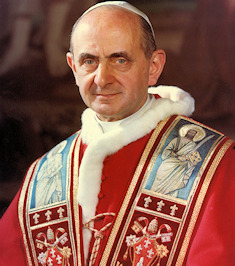Easter: May 29th
Optional Memorial of St. Paul VI, pope
Old Calendar: Friday after Pentecost; St. Mary Magdalen de' Pazzi, virgin
St. Paul VI was canonized and added to the liturgical calendar on January 25, 2019, the Feast of the Conversion of St. Paul. Giovanni Battista Montini was born on September 26, 1897, in a village near Brescia Concesio. On May 29, 1920, he was named Archbishop of Milan. He became Pope on June 21, 1963. He presided over the completion of the Second Vatican Council. He died On August 6, 1978.
According to the 1962 Missal of St. John XXIII the Extraordinary Form of the Roman Rite, today is the feast of St. Mary Magdalen of Pazzi. At the age of ten she consecrated her virginity to Christ, she was a Carmelite famous for her visions. Her motto was "To suffer and not to die." She died in 1607. Her feast in the Ordinary Form of the Roman Rite is celebrated on May 25.
St. Paul VI
Pope Paul VI (Giovanni Battista Montini) was born on 26 September 1897 at Concesio (Brescia), in Italy. On 29 May 1920 he was ordained to the priesthood. In 1924 he began his service to the Supreme Pontiffs, Pius XI and Pius XII, and at the same time exercised his priestly ministry among university students.
Pope Paul VI (Giovanni Battista Montini) was born on 26 September 1897 at Concesio (Brescia), in Italy. On 29 May 1920 he was ordained to the priesthood. In 1924 he began his service to the Supreme Pontiffs, Pius XI and Pius XII, and at the same time exercised his priestly ministry among university students.
Nominated as the Substitute of the Secretariat of State he worked during the Second World War to find shelter for persecuted Jews and refugees. He was later designated Pro-Secretary of State for the General Affairs of the Church, also because of which he knew and encountered many of the proponents of the ecumenical movement. Appointed as Archbishop of Milan, he worked with great care for the diocese.
In 1958, he was elevated to the dignity of a Cardinal of the Holy Roman Church by Pope Saint John XXIII, and following his death was elected on 21 June 1963 to the See of Peter. He immediately continued the work begun by his predecessors, in particular, he brought the Second Vatican Council to its completion and he began many initiatives that showed his solicitude for the Church and for the contemporary world. Among these initiatives we ought to recall his voyages as a pilgrim, undertaken as an apostolic service which served both as a preparation for the unity of Christians and in asserting the importance of fundamental human rights.
Furthermore, he exercised his Supreme Magisterium favouring peace, promoting the progress of peoples and the inculturation of the faith, as well as the liturgical reform, approving Rites and prayers at once in line with tradition and with adaptation for a new age. By his authority he promulgated the Calendar, the Missal, the Liturgy of the Hours, the Pontifical and nearly all of the Ritual for the Roman Rite with the purpose of promoting the active participation of the faithful in the Liturgy. At the same time he saw to it that papal celebrations should take on a more simple form.
At Castel Gandolfo on 6 August 1978, he gave his spirit back to God and, according to his wishes, he was buried just as he had lived, in a humble manner.
Excepted from the Vatican Website

No comments:
Post a Comment